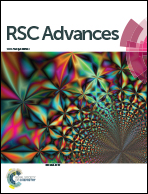In vitro and in silico studies of SARS-CoV-2 main protease Mpro inhibitors isolated from Helichrysum bracteatum†
Abstract
Discovering SARS-CoV-2 inhibitors from natural sources is still a target that has captured the interest of many researchers. In this study, the compounds (1–18) present in the methanolic extract of Helichrysum bracteatum were isolated, identified, and their in vitro inhibitory activities against SARS-CoV-2 main protease (Mpro) was evaluated using fluorescence resonance energy transfer assay (FRET-based assay). Based on 1D and 2D spectroscopic techniques, compounds (1–18) were identified as 24-β-ethyl-cholesta-5(6),22(23),25(26)-triene-3-ol (1), α-amyrin (2), linoleic acid (3), 24-β-ethyl-cholesta-5(6),22(23),25(26)-triene-3-O-β-D-glucoside (4), 1,3-propanediol-2-amino-1-(3′,4′-methylenedioxyphenyl) (5), (−)-(7R,8R,8′R)-acuminatolide (6), (+)-piperitol (7), 5,7,4′-trihydroxy-8,3′-dimethoxy flavanone (8), 5,7,4′-trihydroxy-6-methoxy flavanone (9), 4′,5-dihydroxy-3′,7,8-trimethoxyflavone (10), 5,7-dihydroxy-3′,4′,5′,8-tetramethoxy flavone (11), 1,3-propanediol-2-amino-1-(4′-hydroxy-3′-methoxyphenyl) (12), 3′,5′,5,7-tetrahydroxy-6-methoxyflavanone (13), simplexoside (piperitol-O-β-D-glucoside) (14), pinoresinol monomethyl ether-β-D-glucoside (15), orientin (16), luteolin-3′-O-β-D-glucoside (17), and 3,5-dicaffeoylquinic acid (18). Compounds 6, 12, and 14 showed comparable inhibitory activities against SARS-CoV-2 Mpro with IC50 values of 0.917 ± 0.05, 0.476 ± 0.02, and 0.610 ± 0.03 μM, respectively, compared with the control lopinavir with an IC50 value of 0.225 ± 0.01 μM. The other tested compounds showed considerable inhibitory activities. The molecular docking study for the tested compounds was carried out to correlate their binding modes and affinities for the SARS-CoV-2 Mpro enzyme with the in vitro results. Analyzing the results of the in vitro assay together with the obtained in silico results led to the conclusion that phenylpropanoids, lignans, and flavonoids could be considered suitable drug leads for developing anti-COVID-19 therapeutics. Moreover, the phenylpropanoid skeleton oxygenated at C3, C4 of the phenyl moiety and at C1, C3 of the propane parts constitute an essential core of the SARS-CoV-2 Mpro inhibitors, and thus could be proposed as a scaffold for the design of new anti-COVID-19 drugs.



 Please wait while we load your content...
Please wait while we load your content...